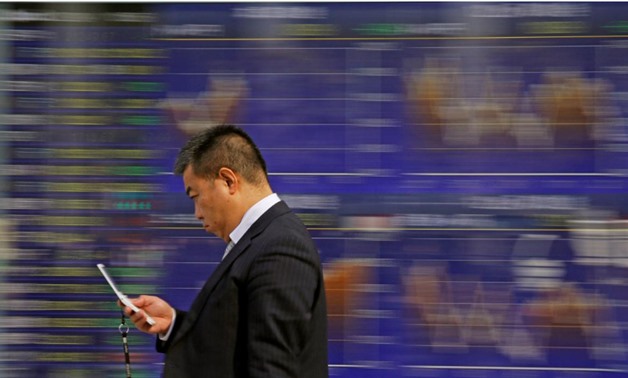
A man walks past an electronic stock quotation board outside a brokerage in Tokyo, Japan, February 9, 2018. REUTERS/Toru Hanai
TOKYO - 21 February 2019: Asian shares pulled ahead to fresh 4-1/2-month highs and U.S. equity futures rose on a Reuters report that the United States and China have started to tackle the stickiest issues in their trade war.
Spread-betters expect Frankfurt’s DAX and Paris’s CAC open up half a percent and 0.4 percent, respectively, and see London’s FTSE basically flat.
MSCI’s broadest index of Asia-Pacific shares outside Japan edged up 0.1 percent, giving up some earlier gains after hitting a peak last seen in early October.
Australian shares gained 0.7 percent, closing at a six-month high, but the Australian dollar tumbled sliding on fears a ban on the country’s coal by a Chinese port would hurt its already slowing economy.
Japan’s Nikkei ended 0.1 percent higher.
U.S. stock futures gained 0.2 percent.
Hong Kong’s Hang Seng rose 0.1 percent, while Chinese blue-chips were last down 0.2 percent, giving up their gains after hitting their highest since early August last year.
Investors have been cheered over recent days by signs of progress in Sino-U.S. trade talks. The trade war between the economic giants has roiled financial markets over the past year.
The United States and China have started to outline commitments in principle on the most contentious issues in their trade dispute, marking the most significant progress yet toward ending a seven-month trade war, sources familiar with the negotiations told Reuters.
Negotiators are drawing up six memorandums of understanding on structural issues: forced technology transfer and cyber theft, intellectual property rights, services, currency, agriculture and non-tariff barriers to trade, the sources said, as the two sides push for an agreement by March 1.
That marks the end of a 90-day truce that U.S. President Donald Trump and Chinese President Xi Jinping agreed to when they met in Argentina late last year.
Trump had suggested on Tuesday he was open to pushing off the deadline to complete negotiations, saying March 1 was not a “magical” date.
FED AFFIRMS “PATIENT” STANCE
Sentiment also got a lift after the U.S. Federal Reserve on Wednesday affirmed it would be “patient” on further interest rate rises.
“We must be a little bit careful that if the trade negotiation would be ended with a temporary success, that could in turn mean the Fed might restart their monetary tightening,” said Yoshinori Shigemi, a global market strategist at JPMorgan Asset Management in Tokyo.
On Wall Street, all three major U.S. equity indexes ended in positive territory on Wednesday after minutes from the Fed’s Jan. 29-30 meeting indicated policymakers see little risk to leaving rates alone, for now.
“The bar to restarting rate hikes in the near term seems to be quite high, with several participants arguing that rate increases would be necessary “only if inflation outcomes were higher than in (the) baseline outlook”,” Paul Ashworth, chief U.S. economist at Capital Economics, said in a note.
“The upshot is we now expect the Fed to leave rates unchanged throughout this year, before a further deterioration in economic growth forces it to cut rates by a total of 75 basis points in 2020,” he said.
The Fed signaled it will soon lay out a plan to stop letting go of $4 trillion in bonds and other assets, though policymakers are still debating how long their newly adopted “patient” stance on U.S. rates will last.
YUAN FIRMS, AUSSIE TUMBLES
In the currency market, the offshore Chinese yuan firmed to its strongest level since July last year on hopes of further progress in the Sino-U.S. trade talks, and was last trading at 6.7076 per dollar.
The onshore yuan last changed hands at 6.7056 yuan per dollar after touching its strongest in three weeks.
The Australian dollar was in the spotlight, sliding more than one percent after customs at China’s northern Dalian port banned imports of Australian coal and said it will cap overall coal imports for 2019.
The Aussie had gained more than half a percent early in the session after employment numbers for January beat expectations though it then reversed course as the underlying soft outlook for the economy reinforced expectations of a possible rate cut this year.
The Aussie was last trading at $0.7097, down 0.9 percent on the day.
The euro held steady at $1.1331. Purchasing manager indexes for the euro zone are due on Thursday and investors are also eyeing the release of minutes from the European Central Bank’s January meeting later in the day.
Against the Japanese yen, the dollar was about 0.1 percent lower at 110.765 yen, moving off a seven-week peak of 111.13 reached last week.
Japanese manufacturing activity contracted in February for the first time in two-and-a-half years as factories cut output amid shrinking domestic and export orders, a private business survey showed on Thursday.
In the commodity market, crude prices rose more than 1 percent on Wednesday to their highest in 2019 on hopes that oil markets will balance later this year.
Oil prices were also helped by output cuts from top producers and U.S. sanctions on the Organization of the Petroleum Exporting Countries (OPEC) members Iran and Venezuela.
U.S. crude was last up 0.3 percent, or 17 cents, at $57.33 per barrel. Brent was 0.1 percent, or 5 cents, higher at $67.13.
Gold was steady at $1,338.50, close to a 10-month peak of $1,346.70 scaled on Wednesday.


Comments
Leave a Comment